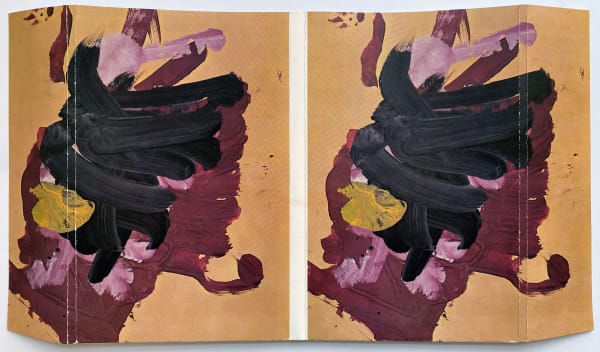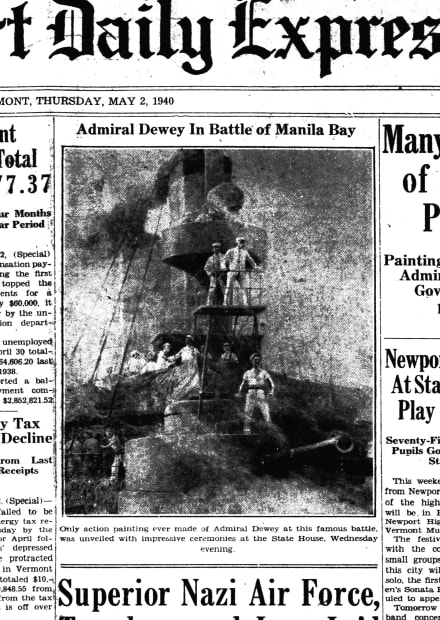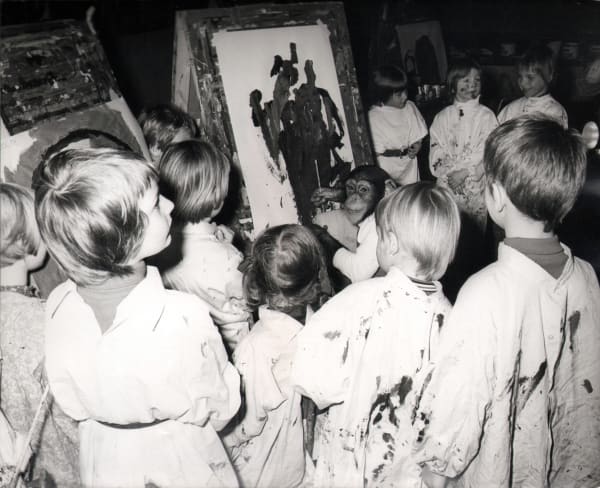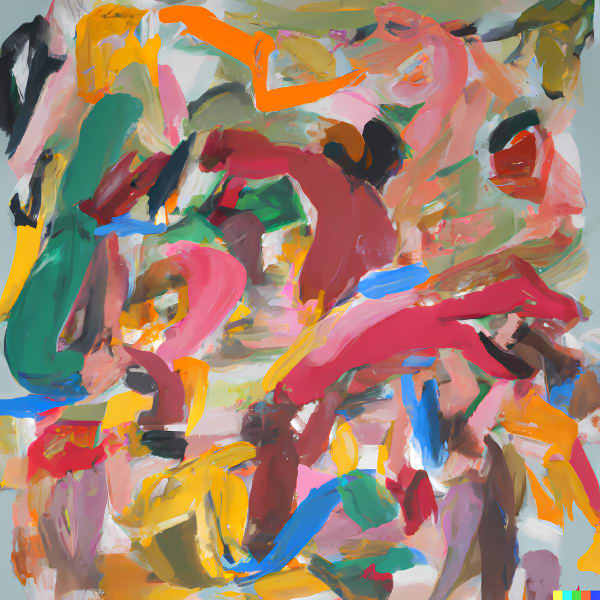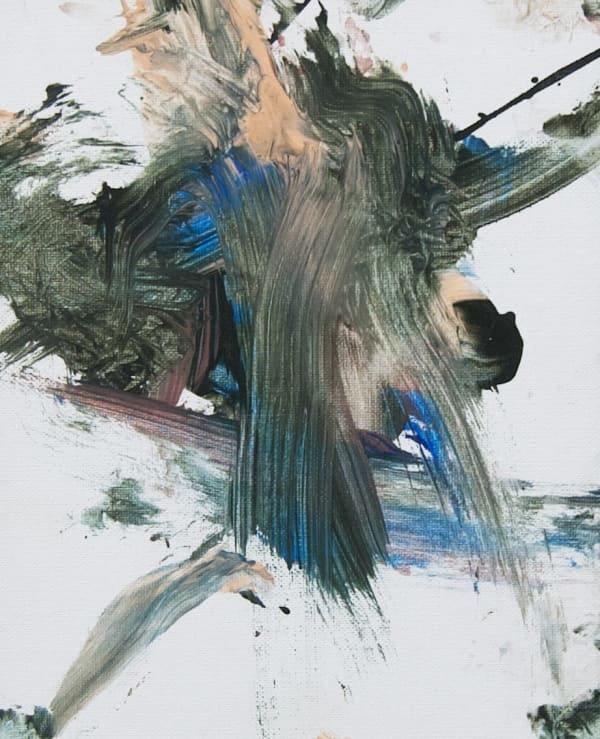-
MONKEY BUSINESS
Curated by David Platzker -
Susan Inglett Gallery and Specific Object are pleased to present “Monkey Business,” an exhibition curated by David Platzker examining the missing link between chimpanzees, Action Painting, and artwork generated by artificial intelligence platforms
-
 Installation view "Monkey Business" Curated by David Platzker at Susan Inglett Gallery, NYC.
Installation view "Monkey Business" Curated by David Platzker at Susan Inglett Gallery, NYC. -
 JACKSON POLLOCK, DOROTHY SEIBERLING Life Magazine, Vol. 47, No. 19, 1959
JACKSON POLLOCK, DOROTHY SEIBERLING Life Magazine, Vol. 47, No. 19, 1959 -
That sentence alone sets the tone for a particular discourse that frequently occupies my mind. Words that form the base ingredients later distilled into a purified mode of artmaking that arose in the mid-1960s. There is no need to bore you further with more details. You could simply say, “it’s history.”
The truth is “conceptual art” was a phrase most “conceptualists” not only wished to distance themselves from—granted the term was one a critic coined to bind together disparate works being made by a relatively small number of international artists—while the artists themselves were mostly annoyed by being unfairly branded by a term as “dry as toast” in the eyes of many critics, curators, and collectors.
-
Over time I began to question my personal involvement in the work surrounding conceptual art. A large part of the questioning was driven by working on an exhibition that had become all-consuming and had brought me to a point where I felt not just my enthusiasm for conceptual art had been desiccated, but I was questioning how narrow my interest in art in general had become due to my investment in the “movement.”
In 2015, during one of my nearly daily strolls through the 5th floor galleries of The Museum of Modern Art, seeking a palate cleanser via a return to less cerebral art, I paused for an extended length of time in front of Jackson Pollock’s One: Number 31, 1950 (1950) and contemplated, as the painting affords one much to contemplate.
-
 JACKSON POLLOCK, ARNOLD NEWMAN, "Jackson Pollock: Is He the Greatest Living Painter in the United States," in Life Magazine, Vol. 27, No. 6, 1949
JACKSON POLLOCK, ARNOLD NEWMAN, "Jackson Pollock: Is He the Greatest Living Painter in the United States," in Life Magazine, Vol. 27, No. 6, 1949 -
 MIAMI NEWS, "Sensation of Art World Uses Nails, Broken Glass" in Miami News, August 14, 1949, 1949,
MIAMI NEWS, "Sensation of Art World Uses Nails, Broken Glass" in Miami News, August 14, 1949, 1949, -
Still this thinking drew me back to conceptualism. As hard as Pollock’s “non-objective” art was pushing against representation he was still producing art within a system. His works are formulations, schemas, built upon a scaffolding of art history that connects his practice to that of artists who came before. That is to say—in paraphrasing Sol LeWitt’s “Sentences on Conceptual Art”—Pollock was a mystic rather than a rationalist. His rational judgments repeated rational judgments, and his illogical judgements led to new experiences and conclusions that logic could not reach.
-
 NEWPORT DAILY EXPRESS, "Admiral Dewey In Battle of Manilla Bay" in the Newport Daily Express, May 2, 1940, 1940
NEWPORT DAILY EXPRESS, "Admiral Dewey In Battle of Manilla Bay" in the Newport Daily Express, May 2, 1940, 1940 -
 Installation view "Monkey Business" Curated by David Platzker at Susan Inglett Gallery, NYC.
Installation view "Monkey Business" Curated by David Platzker at Susan Inglett Gallery, NYC. -
And, while “action painting” is frequently mashed up with the term “abstraction,” doing so is confusing as an “action painting” is not a “abstraction” of a reality. Simply put, it is just what it is, the residue of the actions of the work’s making.
Standing before the Pollock, it was clear to me that coming to terms with One: Number 31, 1950 required a suspension of disbelief. Without some foreknowledge it is hard to appreciate this painting as an artwork.
-
 DALL·E, Action Painting in the Style of Jackson Pollock. png, 2023
DALL·E, Action Painting in the Style of Jackson Pollock. png, 2023 -
Perhaps they, the museum’s visitors, know a bit about Pollock—Jack the Dribbler—who was celebrated not just by the art critics of his time, but in the popular press. That kernel of knowledge sets up the narrative that the artist had formal training and over successive years he pushed against boundaries as he advanced his work along, incrementally, towards his signature style scrawl of strewn house paints. One: Number 31, 1950 is a singular work that launched a flotilla of clichés such as “my kid could do that,” which—like any good cliché—is true to a certain degree.
-
 J. FRED MUGGS, MAD Magazine, No. 38, 1958
J. FRED MUGGS, MAD Magazine, No. 38, 1958 -
I’m sure I’m not the only person that has stood before One: Number 31, 1950 and pondered the infinite monkey theorem, the “theory” that given an infinite amount of time a monkey bashing typewriter keys at random would produce the complete works of William Shakespeare. Perhaps, at the very least, a sonnet or two.
With this thought in my head, still dulled albeit from my deep thoughts about conceptual art, I began to acquire vintage press black-and-white photographs of Christine, Congo, Freida, Homer, J. Fred Muggs, Sally, The Duke of Wellington, Zippy and many other chimpanzees trying their hand at action painting -
These images, reaching back to the 1930s, represent the modern challenges defining anti-illusion, action based, art.
While Pollock made conscious decisions—with regards to materials, scale, and completion—chimpanzees lack such agency. They are provided with paints, charcoal, crayons, or other pigmented media and a fixed sized sheet or canvas to work on. Perhaps a brush or other implement is offered and utilized though fingers are often the preferred tool.
What separates man from ape? In the case of action painting, it’s the capacity to make choices. Choices about materiality, scale, the reflexive nature of gestures that accentuate individual marks. Most importantly, the capacity to step away from the action of creation and recognize that a work is finished.
-
-
Over the years, as I added to my collection of these photographs, I continued to ponder how to best put them to use as a conversation starter, one specifically directed towards concerns of authorship and connoisseurship. I question why we elevate one action painter, or one painting over another when the appreciation of these artists and works is overwhelmingly subjective. How given works under the rubric of action painting are valued—by all definitions of the word—beyond that of formally similar paintings.
-
-
In the last year the rise of works produced by Artificial Intelligence platforms such as DALL-E, GPT, Stable Diffusion and other text-to-image products drew my attention for the same reasons I began to think about the distance between Pollock and primates. Critically the tether between precognition of mission involved in making a work of art and the recognition that the work is part of a continuum of historic art making that presumably only a human enjoys.
-
-
 Unknown Artist, There's No Time for Monkey Business at the Frankfurt Zoo as Easter Nears, 1959
Unknown Artist, There's No Time for Monkey Business at the Frankfurt Zoo as Easter Nears, 1959 -
 Image of David Platzker. Image: Martin Seck
Image of David Platzker. Image: Martin Seck
MONKEY BUSINESS: Curated by David Platzker
Past viewing_room


